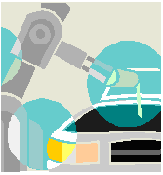|
By : Jim Pinto,

Automation.com, February 2002
|
 Automated factories and processes are too expensive to be rebuilt for every design change - so they have to be highly configurable and flexible. To successfully reconfigure an entire production line or process requires direct access to most of its control elements-switches, valves, motors and drives-down to a fine level of detail.
Automated factories and processes are too expensive to be rebuilt for every design change - so they have to be highly configurable and flexible. To successfully reconfigure an entire production line or process requires direct access to most of its control elements-switches, valves, motors and drives-down to a fine level of detail.
In the real world, situations constantly arise that call for human intervention. When so-called “automated” machines get thrown off track, or become faulty, experts have to be summoned to step in and troubleshoot the problems. But, this expertise is scarce and most often not available when the problems occur. As machines grow more autonomous, the kinds of things that can go wrong with them become steadily more exotic, complex and hard to diagnose (especially when more than one thing goes wrong simultaneously). Moreover, because automated processes tend to run more quickly than manual ones-and are necessarily integrated into other operations around the plant and sometimes even beyond it-the cost and related ripples of letting an exception go uncorrected for even a few minutes can be very high. Today, industrial automation - PLCs and DCS with remote I/O and supervisory HMI - is still relatively in the dark ages as far as complete automation is concerned. There is still too much dependency on manual supervision, which is usually too slow to correct real-time problems. When a serious situation occurs - such as nuclear accidents like the Three Mile Island incident - thousands of alarms occur at once, and manual intervention is ineffective. With a typical automated production line, or process control system, unexpected failures cause significant and expensive downtimes while technicians scramble to diagnose and correct problems. In a semiconductor product plant, millions of dollars worth of components can quickly become junk. By definition, problems arising in automated environments should be detected, diagnosed and fixed “automatically”. To be really effective, automated systems must include predictive and real-time diagnostics, with error-correction that requires little or no manual intervention. Automatic processes and machines must include self-diagnosis and self-correction. The promise of remote-controlled automation is finally making headway in manufacturing settings and maintenance applications. The original machine-based vision of automation-powerful super-robots without people to tend them-underestimated the importance of communications. Today, this is purely a matter of networked intelligence - now well developed and widely available. Communications support of a very high order is now available for automated processes: lots of sensors, very fast networks, quality diagnostic software and flexible interfaces-all with high levels of reliability and pervasive access to hierarchical diagnosis and error-correction advisories through centralized operations. With technology available today, fully automated factories - in a truly realistic sense - are quickly becoming an accepted fact.
|
Return to Index of all JimPinto Writings

 Return to JimPinto.com HomePage
Return to JimPinto.com HomePage
If you have ideas or suggestions to improve this site, contact: webmaster@jimpinto.com
Copyright 2000 : Jim Pinto, San Diego, CA, USA
